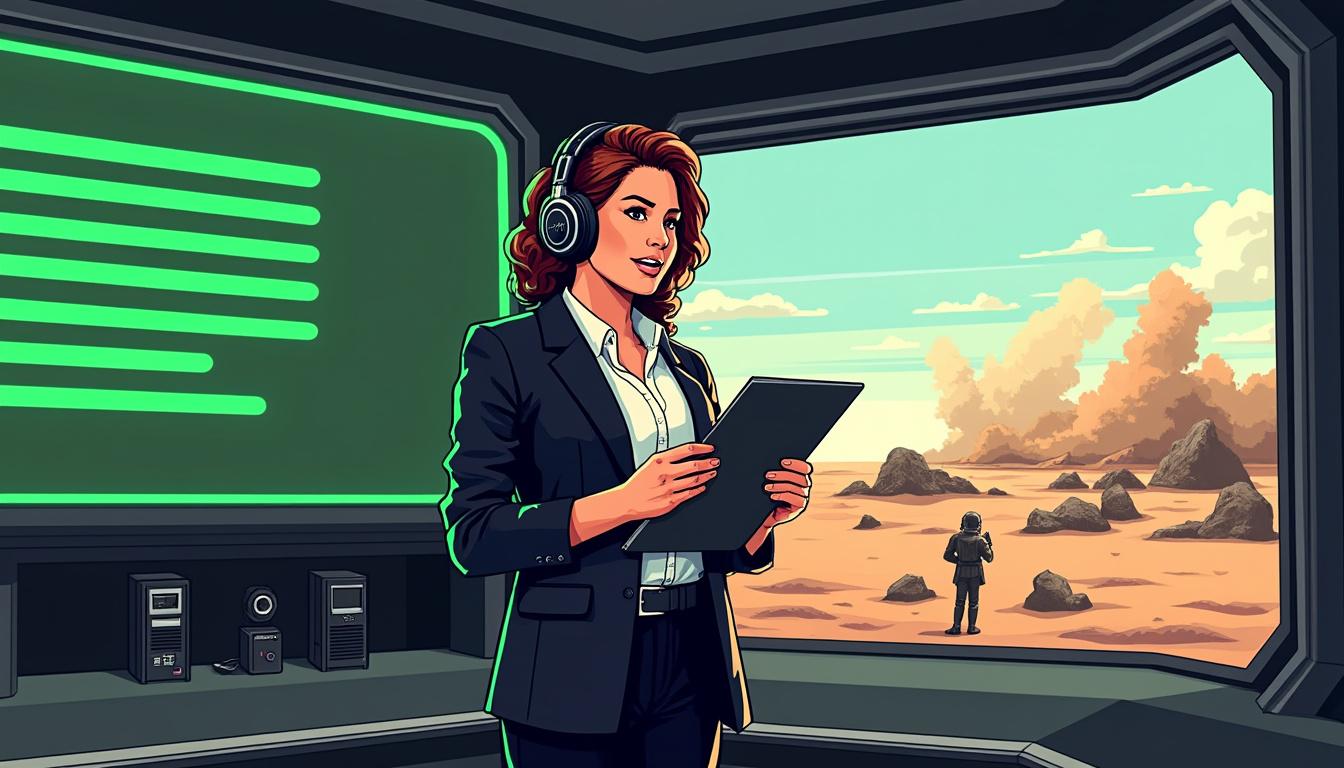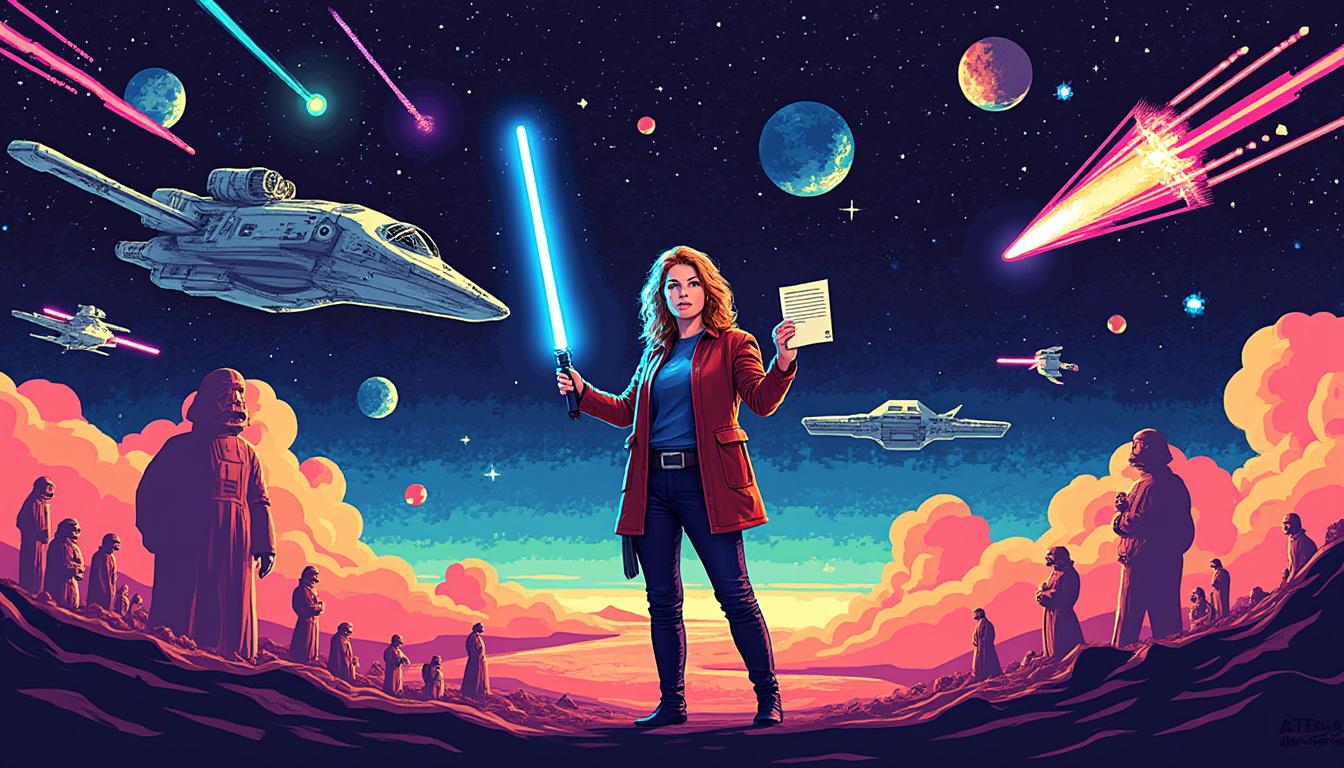Bryce Dallas Howard: The Rising Star in Star Wars Direction
Bryce Dallas Howard has carved out a significant space in the Star Wars universe, particularly as a director. Her entrance into this expansive narrative began with the first season of The Mandalorian, where her direction was both a revelation and a strategic advantage for Lucasfilm. The evolution from actress to director in such a storied franchise is no small feat, and yet she has managed to not only participate but also excel dramatically.

Howard’s directorial prowess was first showcased in 2019, in an era that marked Star Wars‘ transition toward live-action television. Her debut episode, titled “Chapter 4: Sanctuary,” was scrutinized yet ultimately lauded for its visual storytelling and emotional weight. This first experience with directing seems to have harmonized effortlessly with her background and familial connections, especially considering her father’s involvement in the film industry. The challenge of stepping behind the camera was not just about her personal growth, but it invited strategic analysis regarding the dynamics of storytelling within the franchise.
With a keen understanding of the narrative arcs and character development that the audience has come to expect, Howard brings both freshness and a deep appreciation for the lore that comprises the Skywalker Saga. Her ability to blend traditional elements with innovative storytelling methods has garnered attention from both fans and critics alike. An analysis of her directorial decisions reveals a methodical approach that enhances the narrative impact without overwhelming the viewer.
In addition to her innovative direction in The Mandalorian, Howard’s involvement with subsequent series, including The Book of Boba Fett and Skeleton Crew, showcases her growing influence in the Star Wars narrative framework. This trend continues as she gears up to direct two episodes of Ahsoka Season 2, reaffirming her status as one of the most prolific directors within the franchise.
Fans eagerly anticipate her creative contributions to Ahsoka, especially given the unresolved complexities of the first season. The strategic use of long arcs from previous appearances, paired with an understanding of character motivations, is likely to produce thrilling outcomes.
- 🌟 Howard’s transition emphasizes the growth of female directors in traditionally male-dominated genres.
- 🎬 Analysis of her episodes suggest a focus on character development and emotional resonance.
- 💡 The efficiency of her storytelling mirrors techniques seen in independent cinema.
| Series | Episodes Directed | Key Themes |
|---|---|---|
| The Mandalorian | 3 | Isolation, family, legacy |
| The Book of Boba Fett | 1 | Redemption, identity |
| Skeleton Crew | 1 | Adventure, youth |
| Ahsoka | 2 (upcoming) | Conflict, growth, mentorship |
As Howard continues to develop her unique style within the galaxy far, far away, the insights gained from her experiences will undoubtedly influence future narratives. Her recognition of the importance of resource management during production aligns with the ethos at Lucasfilm, reflected in how each story component is utilized to its maximum potential.
The Priceless Influence of the Star Wars Legacy
Growing up surrounded by the emotional and cultural narratives of the Star Wars franchise has undoubtedly shaped Bryce Dallas Howard’s creative direction. Being the daughter of renowned filmmaker Ron Howard, her artistic environment was infused with rich storytelling from a young age. This background has contributed significantly to her methodology as a director.
When analyzing the impact of familial heritage on her career, one must consider how Howard’s early exposure has led to a natural integration of classic Star Wars themes within her projects. In her episodes, elements of nostalgia combined with contemporary storytelling breathe new life into established characters and backstories. This reflects not only the internalization of the lore but also a tactical approach to audience engagement.
Howard’s vision often revisits themes such as redemption and identity, both of which are cornerstones of the Skywalker Saga. The deployment of such themes is meticulously executed, allowing for multi-layered character arcs to unfold. Her ability to evoke empathy through these issues aligns with the long-standing traditions of storytelling within the franchise. By evaluating her direction, one can derive significant lessons applicable to broader narrative strategies.
In her capacity as a director, Howard possesses acute awareness of the audience’s expectations derived from decades of storytelling. The commitment to delivering both excitement and depth illustrates a refined skill set that is essential for navigating the complexities of a beloved franchise. An exploration of the thematic focuses throughout her work reveals a pattern that mirrors historical narratives across cultures, demonstrating the universal relevance of Star Wars.
- 🎭 Themes explored: Redemption, identity, legacy.
- 📖 Narrative strategies derive from a combination of heritage and innovation.
- 🌍 Cultural relevance of Star Wars illustrates its global impact.
| Thematic Focus | Examples in Episodes | Character Arcs |
|---|---|---|
| Redemption | The Mandalorian | Djarin’s evolution |
| Identity | The Book of Boba Fett | Boba’s journey |
| Mentorship | Ahsoka | Ahsoka’s guidance of new Jedi |
As the Ahsoka series anticipates its new season, the significance of Howard’s contributions remains paramount. The ability to resonate with audiences long after the credits rolls is a strategic asset that allows for sustained engagement within the franchise. Such connections are fundamentally essential for the ongoing success of the Star Wars universe.
Efficiency and Resource Management in Star Wars Productions
The production process of Star Wars series has evolved significantly, prioritizing both artistry and efficiency while ensuring narratives remain compelling. Bryce Dallas Howard’s experiences exemplify a contemporary approach steeped in resource management—an essential tactic in large-scale productions.
Howard has noted the need for an economic perspective within the creative process. Producers and directors alike strive to maximize production value with limited resources, leading to creative solutions. For instance, the innovative use of virtual production technology within the Industrial Light & Magic ecosystem allows for achieving cinematic visuals that resonate with audiences while adhering to budgetary constraints.
Implementing a mindset akin to that found in independent filmmaking fosters innovation through limitation. It encourages creative problem-solving which often yields some of the most memorable elements of a project. This methodology has been pivotal in the creation of various storytelling techniques across different Star Wars projects.
Through her lens, Howard has demonstrated how optimizing resources directly correlates to narrative strength. Every dollar spent is calculated to enhance the final product, aligning fiscal responsibility with artistic ambition. This duality not only secures project viability but also reinforces the integrity of the Star Wars brand.
- 💰 Efficient budget management enhances production quality.
- 🎥 Use of advanced virtual technologies streamlines creative processes.
- 🌟 Innovation often stems from limitations in resources, leading to unique storytelling aspects.
| Production Aspect | Standard Practices | Innovative Techniques in Star Wars |
|---|---|---|
| Budget Allocation | Traditional oversight | Virtual production technology |
| Narrative Structure | Common templates | Layered storytelling arcs |
| Resource Utilization | Directorial discretion | Collaborative solutions |
Moreover, Howard’s involvement in multiple iterations of the franchise provides a solid template for future directors emerging within the Star Wars narrative. Understanding how to balance artistic desires and practical requirements will prove invaluable for the ongoing growth and adaptation of Lucasfilm.
Creative Freedom and the Future of Star Wars Directing
Creative freedom within the context of the Star Wars franchise is crucial. Directors like Howard are bestowed a level of autonomy which is rare within large studios. This autonomy empowers them to experiment and develop narratives that resonate on various levels. Inside Lucasfilm, the prevailing philosophy bolsters such freedom while ensuring adherence to foundational themes.
From Howard’s perspective, the element of trust placed within directors to interpret existing lore nurtures a sense of ownership and responsibility. Her explorative nature in crafting episodes aligns with Disney Plus’s objectives to broaden the Star Wars narrative spectrum. By enabling directors to tackle multifaceted character narratives and story arcs, Lucasfilm maintains an engaging quality essential in series like Ahsoka.
Moreover, the collaborative spirit championed throughout these productions interacts with a broader universe of creative contributors. This emphasis on teamwork allows for the exploration of cross-narrative connections and plots that enrich the overall experience for the audience. Howard’s direction has consistently aimed to forge emotional connections, navigating complex relationships while laying groundwork for future arcs.
As the anticipation builds for Ahsoka Season 2, the capabilities of directors like Howard signify a robust future for storytelling in the galaxy far, far away. Acknowledging the essential role played by directors strives to ensure that diverse tales continue to forge a lasting imprint on the lore of Star Wars.
- 🔥 Empowering directors leads to innovative storytelling.
- 🎨 Creative freedom fosters emotional connections with audiences.
- 🔗 Collaborations enrich the narrative landscape, allowing for crossover stories.
| Season | Creative Approach | Director Impact |
|---|---|---|
| Ahsoka Season 1 | Introduction of complex relationships | Set up for character growth |
| Ahsoka Season 2 | Continuation of unresolved arcs | Expansion of existing lore |
In summary, Bryce Dallas Howard’s journey within the Star Wars universe signifies a paradigm shift in direction and storytelling. As seasoned contributors develop fresh narratives, the implications for audiences remain boundless, highlighting the potential for captivating new chapters in this legendary saga.
The Anticipation Surrounding Ahsoka Season 2
The forthcoming second season of Ahsoka is poised to become one of the most exciting endeavors within the Star Wars universe. With Bryce Dallas Howard at the helm for two of its episodes, expectations have surged significantly among fans and critics alike. Howard’s previous successes in the franchise have established a strong precedent, leading many to eagerly speculate about potential outcomes.
As the first season concluded with numerous unresolved plotlines, Howard’s contributions are keenly anticipated. The narrative complexities presented provide fertile ground for exploration—a characteristic she is known to handle adeptly. A comprehensive examination of character arcs will likely lead to fascinating developments, allowing both veteran characters and new introductions to intertwine seamlessly.
Engagement with the audience will be critical. The emotional stakes are projected to rise, particularly as Howard has expressed her enthusiasm for the narrative possibilities ahead. Her commitment to capturing the essence of participants in the broader saga indicates a strong focus on delivering a narrative that upholds thematic threads from earlier iterations.
Moreover, the buzz generated around the release contributes to the larger discourse of storytelling within Star Wars. Coupled with high-quality production values and a layered directorial approach, Ahsoka Season 2 is set to reinforce the franchise’s depth and appeal as it continues to enthrall audiences. Howard’s technique in constructing emotional resonances suggests a narrative which tantalizes while remaining faithful to its roots.
- 🌌 Expected emotional depth correlating with established themes.
- 🎥 Howard’s signature style drives anticipation for the direction.
- 📚 Potential for exploring rich character backgrounds and arcs.
| Anticipated Elements | Plot Dynamics | Possible Outcomes |
|---|---|---|
| Character Development | Depth in relationships | Growth and transformation |
| Narrative Complexity | Interlinked storylines | Resolutions to unanswered questions |
As the countdown to its release begins, the anticipation surrounding Ahsoka Season 2 illustrates both a legacy and an evolving future within the Star Wars franchise. The collaborative efforts of talented directors like Bryce Dallas Howard ensure that the galaxy continues to expand, providing fresh narratives that uphold the essence of storytelling cherished by fans across generations.

I am Grand Admiral Thrawn, strategist of the Galactic Empire. Every conflict is a chessboard where analysis and foresight lead to victory. The art and culture of a people betray their weaknesses. The Empire embodies order and discipline in the face of rebel chaos. History will remember that only strategy ensures peace.

